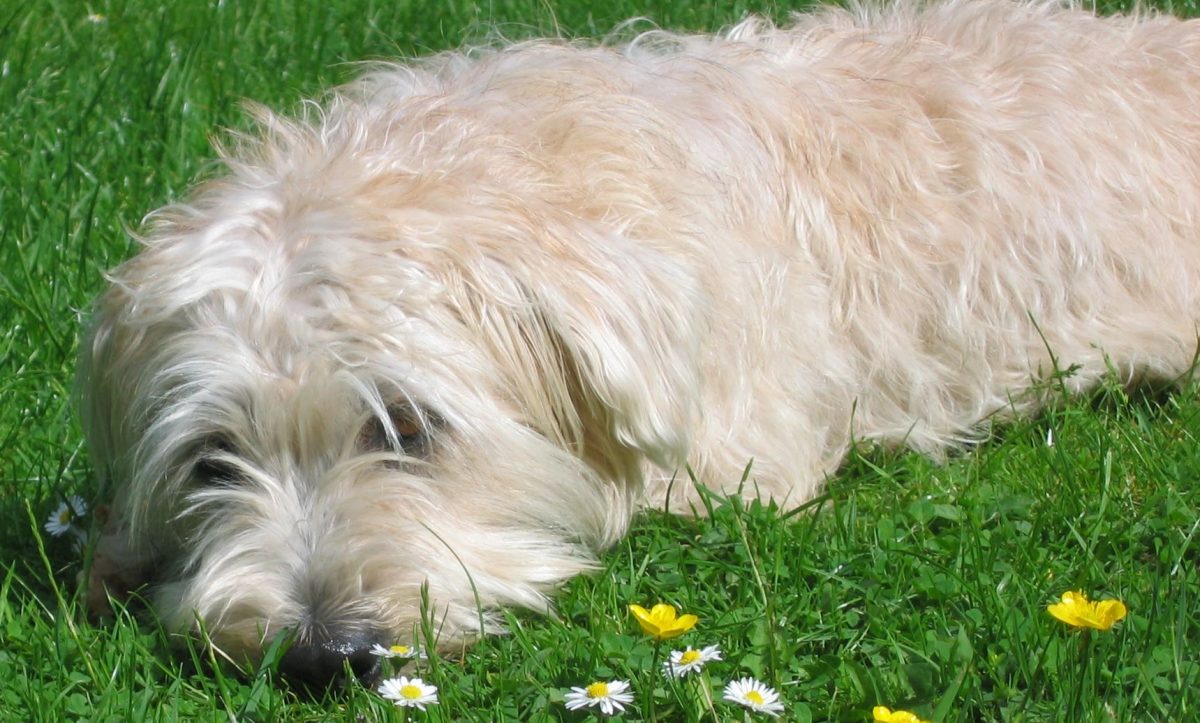Allergies
Gone are the days of single glazing and one coal fire and no house insulation. Gone are the days of the fly swatter or fly paper. Sprays abound for all those creepy crawlies. We even have powders to refresh carpets and upholstery. Weed killers for outside.
Life has changed dramatically over a short period of time. But canine body temperature hasn’t changed – it is still at 38 degrees and so what we regard as comfortable your Glen will be finding uncomfortable. Sprays are toxic in nature as they are designed to kill, but your Glen will be walking through them or over them. Cutting your lawn? the grass oozes sap, your Glen will be walking over it.
Food has changed and most people feed manufactured kibble- the protein level may be too high ( 18% is high enough) and look on the side for the ingredients, some will just say “animal ingredients”. Do you really know what your Glen is eating?
Dogs are sprayed to make the coat glossy or disguise a smell. Are we really surprised that dogs in general develop allergic reactions to their environment.
Your vet can take samples and find out what your dog is allergic to and prescribe treatment to ease the symptoms. Help your dog by addressing these issues
Elbows
There is an ongoing argument as to whether problematic elbows are down to nature or nurture. Unfortunately, as Glens are a numerically small breed, not enough definite information is available in the UK. Below is a transcript from a health symposium held in 2019.
Lynne Fraser Breed Health Co-Ordinator for Glen of Imaal Terrier Association asked “We are very small numerically and Glens are on the endangered list, but we have a few people in our breed who allow their dogs to do things like, run up and down stairs and jump on and off furniture, because they are a dwarf breed this is a big no no. My question is, is there any possibility that problems with the growth plate which we see on occasion could be genetic or is it definitely something which has come about by an injury?
Question – ” Are you thinking of angular deformity? The foot turning outwards on the foreleg?”
Lynne. “The feet do turn out as a general rule but obviously in some it turns out more than others. We have had several dogs that we know of that have had to have surgery because the growth plates have been injured for one reason or another, the owners never say ‘yes we did let them go up and down stairs or we did let them go for long walks’ etc. but we are looking into the fact of whether it could possibly be in the genes as well as having a problem with an injury.”
Answer – “The GOIT is a chondrodystrophic breed and that means you have an abnormal growth in the cartilaginous bone and if that is enhanced in some way then you would have an increased risk of outward rotation of the foot and the foreleg particularly and that could be genetically mediated but it is something to do with chondrodystrophy. What some people say they can see, although I think it is quite difficult to see, is you can get a retained cartilage core in the ulna which is the outer bone of the forearm and so the cartilage core is a remnant of the growing plate which is cartilage and if that stays too long then it is thought that it holds the ulna back from growing and the radius carries on growing and we don’t know the mechanism of that but we know that in some dogs you can get a premature closure of the ulna growth plate and that can be the result of injury but they are not all like that I am sure that some of them are an expression of over osteodystrophy
Answer by:
Dr. Cameron Black,
Clinical Research Officer – Fitzpatrick Referrals, Surrey
* Osteo – bone
*Chondro -cartilage
* Dysplasia- abnormal growth or developement
Hip Dysplasia
The hip is a ball and socket joint. The ball is the head of the femur and the socket is sited at the hip, if there is any deformity in either, this is an indication of Dysplasia. Some countries have started hip scoring their dogs. For that, an appointment at the vet is necessary when the dog is a year old, the dog is heavily sedated, laid on its back and the hind legs pulled out and then x-rayed, the plates then go to the BVA and are scored. Roughly speaking, the breed average is reach by adding all the scores from each Glen together and dividing by the number of dogs scored. To be accurate it needs a large sample of dogs to have been scored.
Another alternative is to have the puppies hips scanned by ultrasound in infancy. The scan shows the roundness of the ball joint and how snugly it fits into the socket. No anaesthesia is required. This is a scheme run by the Pupscan Project at their Carlisle centre.
Alopecia
Basically – baldness. This is not an illness, this is a purely cosmetic problem. It seems to be a lot more prevalent in bitches rather than dogs and is thought to be hormonal. In bitches when seasonal alopecia develops, it is characterised by bald patches in the same place on each side of the dog. Usually occurring about the time a bitch would give birth after her season, over time the hair will slowly grow back.
